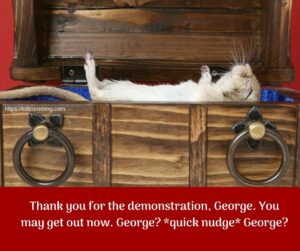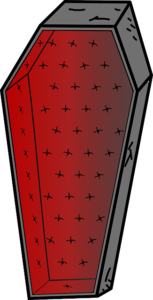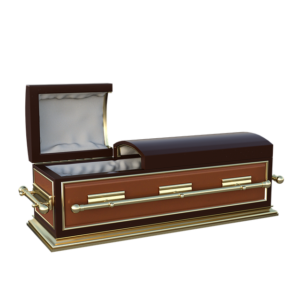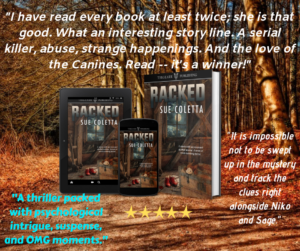By SUE COLETTA
 Last Friday I was editing what I wrote the day before in my WIP when a word stopped me cold: casket. Should that be coffin?
Last Friday I was editing what I wrote the day before in my WIP when a word stopped me cold: casket. Should that be coffin?
The specific year in question is 1901, so I needed to figure out exactly when “coffin” first became “casket”?
The words are often used interchangeably, but they shouldn’t be.
Coffins and caskets give two distinct mental images. I could ruin my scene if I used the wrong word.
Coffin
 The word coffin comes from the Old French word cofin and the Latin word cophinus, which translates to basket. First used in the English language in 1380, a coffin is a box or chest for the display and/or burial of a corpse. When used to transport the deceased, a coffin may also be referred to as a pall.
The word coffin comes from the Old French word cofin and the Latin word cophinus, which translates to basket. First used in the English language in 1380, a coffin is a box or chest for the display and/or burial of a corpse. When used to transport the deceased, a coffin may also be referred to as a pall.
The shape of a coffin resembles the shape of a body, with either six or eight sides, wider at the top to allow for the shoulders, then tapered toward the bottom—the foot, if you will. 😉
Think: Dracula movies.
Coffins date back to ancient Egypt when bodies were placed in a sarcophagus after the mummification process but before being buried in pyramids. Around 700 AD, the Celts in Europe began fashioning ornamental flat stones to coffins.
Casket
 Interestingly enough, the word casket was originally used to describe a jewelry box, similar to the one George modeled in the above photo. 😀
Interestingly enough, the word casket was originally used to describe a jewelry box, similar to the one George modeled in the above photo. 😀
In the mid-nineteenth century, casket took on an additional meaning synonymous with coffin.
Once morticians and undertakers started operating funeral parlors instead of mortuaries, the word coffin changed to casket because polite society considered it less offensive. The exact date still escaped me, though. I also had to consider the location of my story. What if Maine townsfolk used casket while Massachusetts residents still used coffin?
I kept digging…
A casket is rectangular in shape and often has a split-lid for viewing the deceased.
Caskets and coffins have been made of wood, cast iron, steel, fiberglass, real glass, bamboo, wicker, wool, and even gold. Wicker and wool threw me. How ’bout you? Carved whalebone, ivory, or precious metals adorned the ornamental trim, if the family coughed up the extra dough.
Both possess side handles for easy carrying. The main difference is the shape. Which, for writers as well as readers, is a pretty big deal. How would it look if pallbearers carried a triangular coffin? See what I’m sayin’? Details matter.
In 1784, a disturbing new law went into effect for a brief period. Holy Roman Emperor Joseph II declared coffins should be reused to save on wood. So, coffin-makers installed trap doors on coffin floors that would drop open as soon the wood hit the grave. After the funeral service, the undertaker would hoist the coffin out of the hole, rinse and repeat. Public outcry abolished the law six months later.
That’s all well and good — fascinating, even; I love learning new tidbits for the ol’ memory bank — but I still hadn’t answered my original question. Should I use coffin or casket in my WIP? Some might not understand a writer’s obsession over one tiny word, but TKZers know every word counts. More importantly, they must be the right words.
Next, I read about the different materials used in coffins…
From 1848 through the 1870’s Almond Fisk made some coffins out of cast-iron. Shaped like a sarcophagus, they weighed over 300 pounds. Total cost: $100. How many pallbearers would it take to carry 400, 500, 600 pounds of dead weight?
Wooden coffins sold for $1.00 to $3.00 during that time. Imagine? Today some “burial boxes” can cost a whopping $50,000., depending on material and style.
In 1950, Fisk died penniless after mortgaging his patent rights to John G. Forbes, who resurrected the company and continued the cast-iron coffin business till it folded in 1888. The affluent members of society, however, preferred cast-iron coffins to wood; they helped to deter grave robbers. In fact, some say General Ulysses S. Grant is buried in a steel casket for this very reason.
Edgar Allan Poe’s The Premature Burial added to the chaos of the 1700’s and 1800’s, when folks feared being buried alive. Which is when coffin-makers introduced the safety coffin, complete with cord and bell. We’ve all heard those stories, right? Countless novels, short stories, novellas, film adaptations, and even plays hopped on that particular bandwagon.
Poe’s The Premature Burial exacerbated many people’s worst fear.
The lady was deposited in her family vault, which, for three subsequent years, was undisturbed. At the expiration of this term it was opened for the reception of a sarcophagus; — but, alas! how fearful a shock awaited the husband, who, personally, threw open the door! As its portals swung outwardly back, some white-appareled object fell rattling within his arms. It was the skeleton of his wife in her yet unmolded shroud.
A careful investigation rendered it evident that she had revived within two days after her entombment; that her struggles within the coffin had caused it to fall from a ledge, or shelf to the floor, where it was so broken as to permit her escape. A lamp which had been accidentally left, full of oil, within the tomb, was found empty; it might have been exhausted, however, by evaporation.
On the uttermost of the steps which led down into the dread chamber was a large fragment of the coffin, with which, it seemed, that she had endeavored to arrest attention by striking the iron door. While thus occupied, she probably swooned, or possibly died, through sheer terror; and, in failing, her shroud became entangled in some iron — work which projected interiorly. Thus she remained, and thus she rotted, erect.
As you can probably guess, I got sucked right into the master of darkness’ story instead of searching for the answer to my research question! It wasn’t easy — Edgar Allan Poe’s mind intrigues me — but I finally managed to refocus on the task at hand.
Turns out, I had the answer all along in my printed research paperwork, hidden in a news article. The story told of a victim’s father who argued over the price of his daughter’s coffin, believing he should be charged the wholesale price rather than retail. *facepalm*
Ah, well, I figured, maybe I can use this casket/coffin research for my Monday post on the Kill Zone. 🙂 There must be a lesson or two in here somewhere. Or maybe, just maybe, this information might save one of you research time in the future.
What say you, my beloveds? Have you ever gotten hung up on one word? Did it lead you to uncover a fascinating tidbit or two? Tell us about it.
International Thriller Writers wrote a feature article about RACKED, which I’m still *happy dancing* about. If you’re interested, you can read the full article HERE.
The ebook of RACKED is on sale for 99c on Amazon for another day or two.
*All books in the series can stand alone.


I check words all the time often in the online British Newspaper Archive. I checked ‘coffin’ in 1919 the year my novel is set in.
Coffins of concrete. Said to be, lighter and cheaper, than wooden ones. Middlesbrough Corporation Committee are inspect samples of concrete coffins, with a view to sanctioning their use in local burial grounds. (Taunton Courier 26 November 1919)
Fabulous tidbit, Sylvia! Thanks for sharing. If you use a concrete coffin in your WIP, you may want to read this post: https://www.vice.com/en_us/article/7b775g/how-to-avoid-being-an-exploding-corpse-814
Somewhere along the way public pressure forced the industry to seal coffins and caskets, and they really should never be air-tight. Bodies need ventilation or we turn into a gooey mess. Although, a brave writer could use this knowledge to cause conflict for the hero. 😉
Interesting. Never know when this kind of trivia will be useful, and yes, the right word, or the wrong one, can make a huge difference in the believability of a story.
Thank you for sharing and thanks on the heads up about your book! I snatched my copy. Looking forward to a good read! 🙂
Right? You never know. 🙂
Thanks, Cecilia. Happy reading!!!
I recently learned the difference between a cemetery and a graveyard. A graveYARD is attached to a churchYARD. Standalone burial spaces are cemeteries. Or, so I was told.
Wow, John. That’s excellent information. Thanks for sharing!
A riveting subject! I love etymology so I was quite caught up in your search. In my last WIP I was criticized for my use of the word ‘deadfall’ as in a tangled mass of fallen trees and brush. I had researched it’s use, but my group was hung up on the alternate definition, a trap consisting of a heavy weight positioned to fall on an animal.
Thanks, Julie! I like using alternate definitions sometimes, as long as it doesn’t cause confusion. Go with your gut. 🙂
As an editor, I research words frequently to double-check myself and the author when something doesn’t quite “feel” right. And like you, I often get so caught up in the research that I wander off on an interesting path of discovery. Morning and burial customs are also distinctive around the world and vitally important when incorporating them into the book. I recently stumbled on a new show on Netflix to discover that in one New Zealand funeral home, they offer coffins in neon colors, with dogs and cats on the sides, and one with LED lights that change colors!
Wow, Mahala! I had no idea coffins came in neon colors with dogs and cats on the sides. That’s fascinating.
Okay, I’m being stupid here. Would you mind clarifying this sentence, “Around 700 AD, the Celts in Europe began fashioning ornamental flat stones to coffins.”
I love words, pesky evil devils that they are. Writing mainly contemporary I’ve not had to worry too much about authenticiy, but one of my former secret pleasures were short, sweet Regency romances. Early in the Regency period, “mushrump” hadn’t become “mushroom” yet. (Say “mushrump” fast a number of times, then have a good Minion giggle.) In Ton speak, a “mushrump” was a hanger-on with pretentions and hopes of gain like a mushrump who were always under giant elegant oaks. What a put down!
There are some really excellent period dictionaries of words and slang of words in general, and particular periods. The OXFORD ENGLISH DICTIONARY is the best go-to for Europeon English. It will list the first use of the word and the date.
In my research “Celt” is the term they used for the Irish in that specific time period. Sorry if the word offended you, Marilynn. I would never intentionally offend anyone.
Fascinating info about mushrooms. Thanks for sharing!
I know who the Celts are, and not offended. My question was about the stone they used. Was it like a coffin, a mausoleum, or a tombstone?
Oh! Okay, gotcha. The stones they used were small, flat, decorative stones to spruce up the coffin.
You KNOW I’d introduce a different set of etymological problems.
As some of you know, and not many people care, I am legally half Muscogee Creek and half Kiowa; the Kiowa side includes my great-great-great Southern Cheyenne grandma, A-gope-tah. You can find her on the internet.
But I am struggling with a story line that includes the Creeks of both Oklahoma and the Southeastern United States. Here’s why:
Although currently more in the ufo-bigfoot-dogmen system of thought–okay, more conspiracy theorishy than science–an idea has arisen that the Creek Indians are descendants of the Mayans. Right now, that idea is built more on words studies in both languages, and ancient architecture found in the Southeast. Oh, and Mayan Blue.
If you saw Mel Gibson’s movie, Apolcalypto, then you know about Mayan Blue. It’s the thick blue paint that the girls in the Mayan city dabbed on the men of Jaguar Paw’s little tribe. So, pay attention class. There are Mayans in what is now Central and South America. There has not been enough of the clay from which Mayan Blue is made, found in either land mass. So, where did they get the Mayan Blue clay. If you guessed the Southeaster United States, then, as my high school Sophomore English teacher used to say, you done good.
Quickly, quickly: there are Mayan-like pyramids found in, you guessed it, Georgia. If that interests you, there are pictures found on, you also guessed it, a conspiracy theory site: https://realspooks.com/tag/mayan-connection/. (If you go there, don’t forget to eliminate the period before pasting the URL into your browers.)
Word studies are interesting. Miami? See https://lostworlds.org/mayan-words-georgias-indians/.
See my problem? No? Well, you will if you read the articles on both of these blogs. It’s how we could have gotten rid of that monster, Andrew Jackson.
I smiled the whole way through your comment, Jim. Although I had no idea Mayan-like pyramids are in Georgia, I’m right there with you on Andrew Jackson being a monster. Thanks for the links! I look forward to reading the blogs… just as soon as I finish the chapter I’m working on. 😉
Michael Crichton’s “The Great Train Robbery” delves into coffins and the rather interesting question of when is someone dead? He talks about the bells attached to toes and the apparently very real fear of being buried alive.
I am Jewish. For the past 2,000 years or so, plain wooden boxes pinned together with wood dowels have been the norm. In a world where a steel and satin coffin can set your family back $15,000, the around $1,000 for a “fancy” all wood box is fine by me.
Haha. I hear ya, Alan! I told my husband, just bury me a la naturale under my favorite tree, but deep enough so animals won’t dig me up. It may upset him to look out the window and see a dog taking off with my humerus bone. 🙂